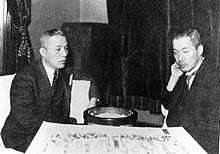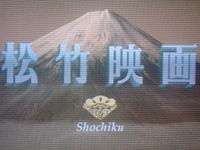Shochiku
|
| |
|
Shochiku HQ in Tokyo | |
Native name | 松竹株式会社 |
|---|---|
| Public (TYO: 9601) | |
| Industry | Entertainment (Movie) |
| Founded | 1895 (in Tokyo, Japan as a kabuki production company) |
| Founders | Takejirō Ōtani (大谷竹次郎) and Matsujirō Shirai (白井松次郎) |
| Headquarters | Tsukiji 4-1-1, Chuo City, Tokyo, Japan |
| Revenue | 8.8 billion Yen (2014) |
Number of employees | 1227 (2014) |
| Subsidiaries | Shochiku Broadcasting Co., Ltd. |
| Website |
www |
Shochiku Company Limited (松竹株式会社 Shōchiku Kabushiki gaisha) (TYO: 9601) is a Japanese movie studio and production company for kabuki. It also produces and distributes anime films. Its best remembered directors include Yasujirō Ozu, Kenji Mizoguchi, Mikio Naruse, Keisuke Kinoshita and Yōji Yamada. Shochiku has also produced films by highly regarded independent and "loner" directors such as Takashi Miike, Takeshi Kitano, Akira Kurosawa and Taiwanese New Wave director Hou Hsiao-Hsien.
History
As Shochiku Kinema

The company was founded in 1895, which makes it the oldest company in Japan involved in film production.[1] Founded by the brothers Takejirō Ōtani (大谷竹次郎) and Matsujirō Shirai (白井松次郎), it was originally a kabuki production company, and was named “Matsutake” in 1902 after the combined kunyomi reading of the kanji take (bamboo) and matsu (pine) from their names, reflecting the traditional three symbols of happiness, bamboo, pine, and plum. The name was changed in 1937 to the onyomi reading of Shōchiku.[2]
Shochiku grew quickly, expanding its business to many other Japanese live theatric styles, including Noh and Bunraku, established a near monopoly due to its ownership of theaters, as well as kabuki and shimpa drama troupes. [1]
The company began making films in 1920, about a decade after its main rival Nikkatsu. Renaming itself “Shochiku Kinema”, the company sought to break away from the prevailing pattern of jidai-geki and to emulate Hollywood standards. It was the first film studio to abandon the use of female impersonators and brought new ideas, including the star system and the sound stage to Japan. It built its main studio at Kamata, between Tokyo and Yokohama, and hired Henry Kotani, an American-born Japanese who had worked in Hollywood as an actor to direct its first film, “Island Woman” (Shima no Onna, 1920). However, Shochiku’s early history was difficult, as audiences preferred the more action-packed jidai-geki historical swashbucklers over the Shimpa melodramas, and its Kamata studios were destroyed by the 1923 Great Kantō earthquake, forcing a temporary relocation to Kyoto. [1]
With the reopening of its Kamata studios, Shochiku also introduced the shomin-geki genre[3] “shomin-geki” genre, with stories reflecting the lives of the lower-middle urban classes. These dramas proved immensely popular, and marked the start of the careers of many prominent directors (including Ozu, Naruse, and Hiroshi Shimizu) and actors (including Kinuyo Tanaka).
In 1931, Shochiku released the first “talkie” made in Japan: “The Neighbor’s Wife and Mine” (Madamu to nyobu, 1930). Filming became increasing difficult at the Kamata studios during the 1930s with the rapid industrialization of the surrounding area with munitions factories and metal foundries, and Shochiku decided to close the studio and relocate to Ofuna, near Kamakura in 1936. The following year, Shochiku Kinema was merged with its parent company, Shochiku Entertainment, and adopted the new name of Shochiku Corporation. [1]
As Shochiku Corporation

During the war years, Shochiku's President, Shiro Kido, helped establish the Dai Nippon Eiga Kyokai (Greater Japan Film association), whose purpose was to coordinate the industry's efforts with Japanese government policy. From the mid-1930s until 1945, the films produced by Shochiku and other Japanese movie companies were propagandistic.
After the surrender of Japan, Kido and Shochiku's co-founder Otani were arrested and charged with Class-A war crimes by the Allied occupation authorities. [1]
In 1953, after the end of the Occupation, Kido returned to Shochiku and revived the melodramatic style of films which had been a Shochiku trademark in the pre-war era. Directors associated with Shochiku in this era included Ozu, Keisuke Kinoshita, Noboru Nakamura and Hideo Oba. Many of the films during the 1950s were aimed primarily at female audiences. In particular, Hideo Oba’s “What is Your Name?” (Kimi no na wa?, 1953) was the most commercially successful film of the period. [1]
By the start of the 1960s, Shochiku’s films were criticized as “old-fashioned” with the popularity of rival Nikkatsu’s Taiyo-zoku youth-orientated movies. The studio responded by launching the Japanese New Wave (Nuberu bagu) which also launched the career of Nagisa Oshima among others,[3] though Oshima soon went independent; the films of Oshima and other film makers were not financially successful and the company changed its policies.[3]
However, the growing threat of television led to the bankruptcy of Shochiku’s competitors, Shintoho in 1961 and Daiei in 1971, whereas Nikkatsu and Toei turned to gangster movies and soft pornography to maintain attendance. Shochiku continued to maintain its family-orientated audience largely due to the phenomenal success of the Otoko wa Tsurai yo series directed by Yoji Yamada from 1969 through 1997. However, with the death of its star Kiyoshi Atsumi, the series came to an end, and the company faced increasing financial difficulties. [1]
The Ofuna studio was briefly transformed into a theme park, Kamakura Cinema World, but this was closed in 1998 and the site was sold off in 2000 to Kamakura Women's College.
Since that time, Shochiku has relied on its film studio and backlot in Kyoto.
Yoji’s “The Twilight Samurai” (Tasogare Seibei, 2002) was nominated for an Oscar as Best Foreign Language Picture. [1]
Shochiku has also served as a distributor of theatrical anime. Major titles have included the Cardcaptor Sakura films, Mobile Suit Gundam movies, Origin: Spirits of the Past, Piano no Mori, Ghost in the Shell, Fullmetal Alchemist the Movie: Conqueror of Shamballa, Fullmetal Alchemist: The Sacred Star of Milos, Sword of the Stranger, and Jungle Emperor Leo.
Shareholders
as of October 2015
- Kabuki-za Theatrical Corp., 3.44%
- Mizuho Corporate Bank, 3.22%
See also
References
External links
![]() Media related to Shochiku at Wikimedia Commons
Media related to Shochiku at Wikimedia Commons
.jpg)